Input interpretation

antimony (chemical element) | silver (chemical element) | tin (chemical element)
Periodic table location
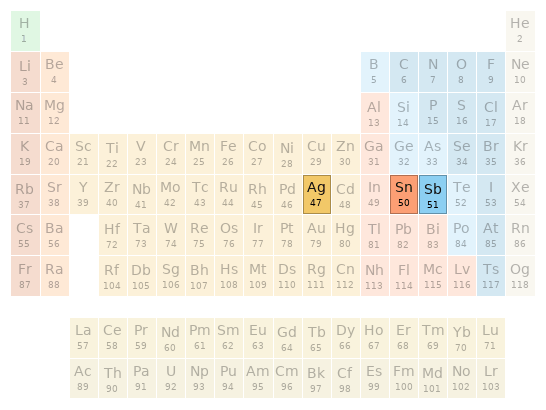
Periodic table location
Images
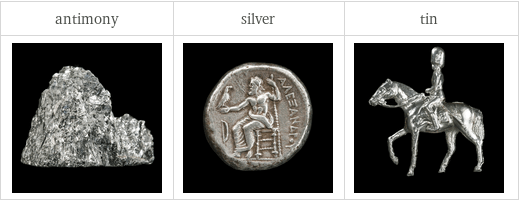
Images
Basic elemental properties
![| antimony | silver | tin atomic symbol | Sb | Ag | Sn atomic number | 51 | 47 | 50 short electronic configuration | [Kr]5s^24d^105p^3 | [Kr]5s^14d^10 | [Kr]5s^24d^105p^2 Aufbau diagram | 5p 4d 5s | 4d 5s | 5p 4d 5s block | p | d | p group | 15 | 11 | 14 period | 5 | 5 | 5 atomic mass | 121.76 u | 107.8682 u | 118.71 u half-life | (stable) | (stable) | (stable)](../image_source/fa15d2204a667ade63871fd0c6d12d29.png)
| antimony | silver | tin atomic symbol | Sb | Ag | Sn atomic number | 51 | 47 | 50 short electronic configuration | [Kr]5s^24d^105p^3 | [Kr]5s^14d^10 | [Kr]5s^24d^105p^2 Aufbau diagram | 5p 4d 5s | 4d 5s | 5p 4d 5s block | p | d | p group | 15 | 11 | 14 period | 5 | 5 | 5 atomic mass | 121.76 u | 107.8682 u | 118.71 u half-life | (stable) | (stable) | (stable)
Thermodynamic properties
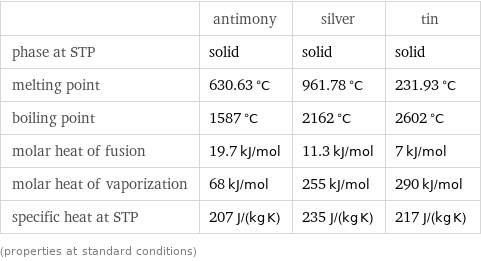
| antimony | silver | tin phase at STP | solid | solid | solid melting point | 630.63 °C | 961.78 °C | 231.93 °C boiling point | 1587 °C | 2162 °C | 2602 °C molar heat of fusion | 19.7 kJ/mol | 11.3 kJ/mol | 7 kJ/mol molar heat of vaporization | 68 kJ/mol | 255 kJ/mol | 290 kJ/mol specific heat at STP | 207 J/(kg K) | 235 J/(kg K) | 217 J/(kg K) (properties at standard conditions)
Material properties
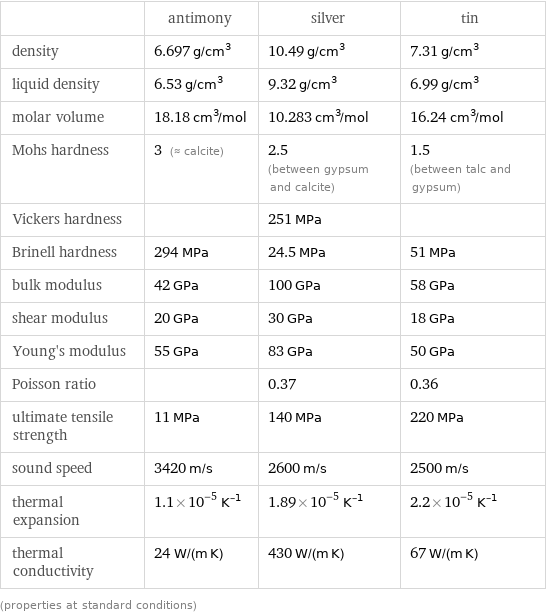
| antimony | silver | tin density | 6.697 g/cm^3 | 10.49 g/cm^3 | 7.31 g/cm^3 liquid density | 6.53 g/cm^3 | 9.32 g/cm^3 | 6.99 g/cm^3 molar volume | 18.18 cm^3/mol | 10.283 cm^3/mol | 16.24 cm^3/mol Mohs hardness | 3 (≈ calcite) | 2.5 (between gypsum and calcite) | 1.5 (between talc and gypsum) Vickers hardness | | 251 MPa | Brinell hardness | 294 MPa | 24.5 MPa | 51 MPa bulk modulus | 42 GPa | 100 GPa | 58 GPa shear modulus | 20 GPa | 30 GPa | 18 GPa Young's modulus | 55 GPa | 83 GPa | 50 GPa Poisson ratio | | 0.37 | 0.36 ultimate tensile strength | 11 MPa | 140 MPa | 220 MPa sound speed | 3420 m/s | 2600 m/s | 2500 m/s thermal expansion | 1.1×10^-5 K^(-1) | 1.89×10^-5 K^(-1) | 2.2×10^-5 K^(-1) thermal conductivity | 24 W/(m K) | 430 W/(m K) | 67 W/(m K) (properties at standard conditions)
Electromagnetic properties
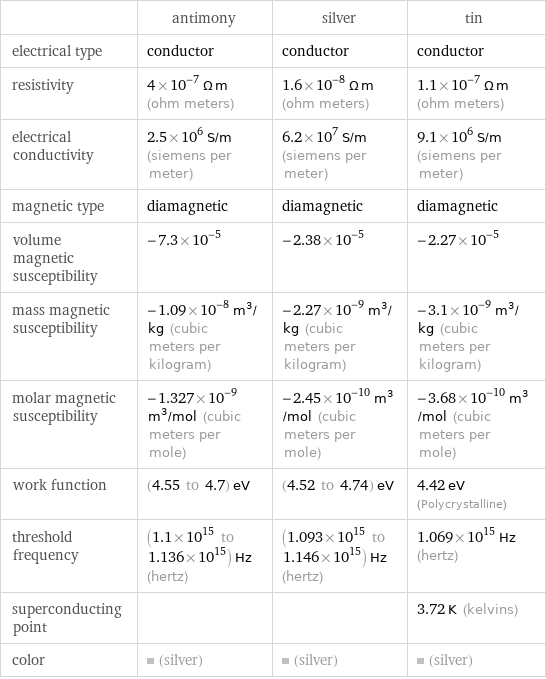
| antimony | silver | tin electrical type | conductor | conductor | conductor resistivity | 4×10^-7 Ω m (ohm meters) | 1.6×10^-8 Ω m (ohm meters) | 1.1×10^-7 Ω m (ohm meters) electrical conductivity | 2.5×10^6 S/m (siemens per meter) | 6.2×10^7 S/m (siemens per meter) | 9.1×10^6 S/m (siemens per meter) magnetic type | diamagnetic | diamagnetic | diamagnetic volume magnetic susceptibility | -7.3×10^-5 | -2.38×10^-5 | -2.27×10^-5 mass magnetic susceptibility | -1.09×10^-8 m^3/kg (cubic meters per kilogram) | -2.27×10^-9 m^3/kg (cubic meters per kilogram) | -3.1×10^-9 m^3/kg (cubic meters per kilogram) molar magnetic susceptibility | -1.327×10^-9 m^3/mol (cubic meters per mole) | -2.45×10^-10 m^3/mol (cubic meters per mole) | -3.68×10^-10 m^3/mol (cubic meters per mole) work function | (4.55 to 4.7) eV | (4.52 to 4.74) eV | 4.42 eV (Polycrystalline) threshold frequency | (1.1×10^15 to 1.136×10^15) Hz (hertz) | (1.093×10^15 to 1.146×10^15) Hz (hertz) | 1.069×10^15 Hz (hertz) superconducting point | | | 3.72 K (kelvins) color | (silver) | (silver) | (silver)
Reactivity
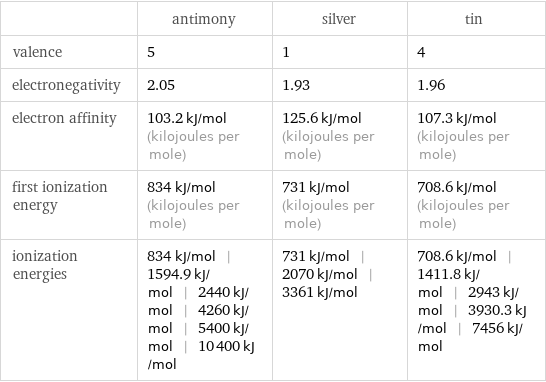
| antimony | silver | tin valence | 5 | 1 | 4 electronegativity | 2.05 | 1.93 | 1.96 electron affinity | 103.2 kJ/mol (kilojoules per mole) | 125.6 kJ/mol (kilojoules per mole) | 107.3 kJ/mol (kilojoules per mole) first ionization energy | 834 kJ/mol (kilojoules per mole) | 731 kJ/mol (kilojoules per mole) | 708.6 kJ/mol (kilojoules per mole) ionization energies | 834 kJ/mol | 1594.9 kJ/mol | 2440 kJ/mol | 4260 kJ/mol | 5400 kJ/mol | 10400 kJ/mol | 731 kJ/mol | 2070 kJ/mol | 3361 kJ/mol | 708.6 kJ/mol | 1411.8 kJ/mol | 2943 kJ/mol | 3930.3 kJ/mol | 7456 kJ/mol
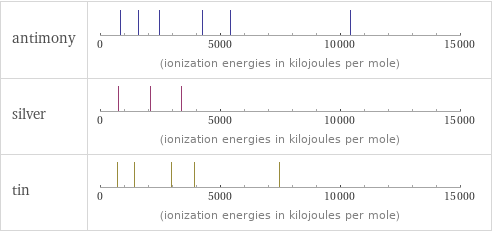
Reactivity
Atomic properties
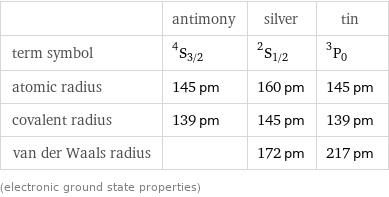
| antimony | silver | tin term symbol | ^4S_(3/2) | ^2S_(1/2) | ^3P_0 atomic radius | 145 pm | 160 pm | 145 pm covalent radius | 139 pm | 145 pm | 139 pm van der Waals radius | | 172 pm | 217 pm (electronic ground state properties)
Abundances
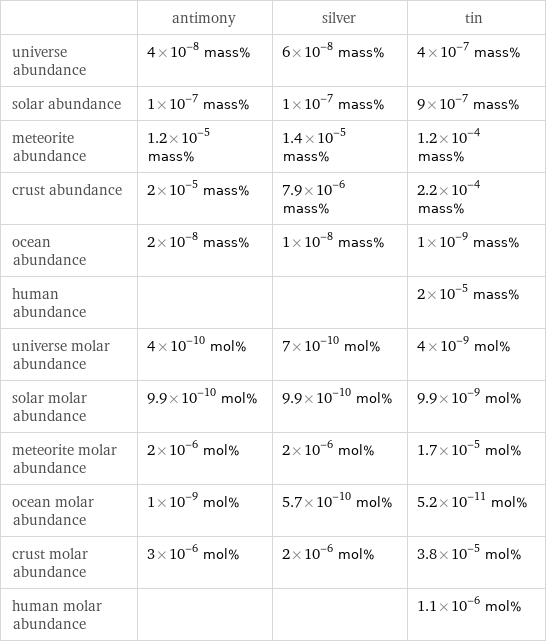
| antimony | silver | tin universe abundance | 4×10^-8 mass% | 6×10^-8 mass% | 4×10^-7 mass% solar abundance | 1×10^-7 mass% | 1×10^-7 mass% | 9×10^-7 mass% meteorite abundance | 1.2×10^-5 mass% | 1.4×10^-5 mass% | 1.2×10^-4 mass% crust abundance | 2×10^-5 mass% | 7.9×10^-6 mass% | 2.2×10^-4 mass% ocean abundance | 2×10^-8 mass% | 1×10^-8 mass% | 1×10^-9 mass% human abundance | | | 2×10^-5 mass% universe molar abundance | 4×10^-10 mol% | 7×10^-10 mol% | 4×10^-9 mol% solar molar abundance | 9.9×10^-10 mol% | 9.9×10^-10 mol% | 9.9×10^-9 mol% meteorite molar abundance | 2×10^-6 mol% | 2×10^-6 mol% | 1.7×10^-5 mol% ocean molar abundance | 1×10^-9 mol% | 5.7×10^-10 mol% | 5.2×10^-11 mol% crust molar abundance | 3×10^-6 mol% | 2×10^-6 mol% | 3.8×10^-5 mol% human molar abundance | | | 1.1×10^-6 mol%